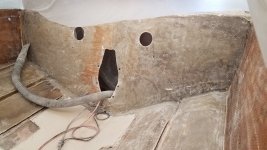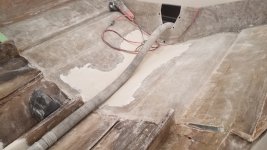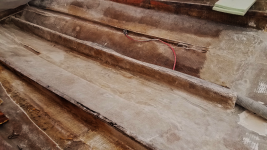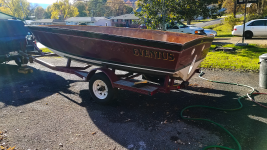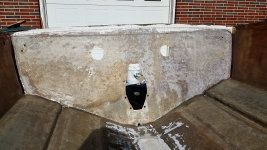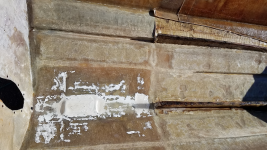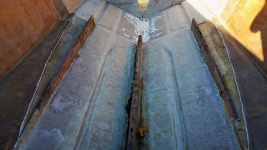Reserector_
Chief Petty Officer" & 2021 Splash of the Year Win
- Joined
- Oct 15, 2019
- Messages
- 650
Let me preface this by saying that my only experience is what you've read in my thread. But you're a smart guy, and you've done your homework, so I will share my thoughts.
Transom will depend on how flat the wood fits to the hull. If it is flat, and won't have any dips or gouges in it, you could go with a couple layers of CSM. If it is full of pockets, you will be better off with PB.
Joining the two layers of plywood can be done with resin only, or one layer of CSM. You will need a way to clamp or weight it, pressing from the center out. I would suggest gluing laminating the transom before installing it, and before cutting any holes. (Better to work flat when you can.) Once it is laminated, test fit and trim, mark and cut the holes. I say that because the holes will give you places to run C-clamps through. Definitely prep the holes like PC did: https://forums.iboats.com/threads/90-maxum-2100sr-restoration-conversion.730950/page-5#post-5615352
Your tabbing schedule looks good.
Stringers can be covered with CSM in the flat before bedding them in. Leave it up from the bottom far enough not to interfere with the hull. That may mean more clearance on one side than the other. You just want it in range of the tabbing for an overlap.
If the floor will go on top, trip the CSM at the top edge. seal the edge with resin, and plan on the glue or PB to insure a seal on the top edge.
If you have a center stringer that needs to be capped, round the top edges. I would go with CSM there, as well.
On the deck I would go with more than a single layer of CSM to insure a good protective layer. One exception might t be if you use carpet glue as your redundant layer of sealant.
Transom will depend on how flat the wood fits to the hull. If it is flat, and won't have any dips or gouges in it, you could go with a couple layers of CSM. If it is full of pockets, you will be better off with PB.
Joining the two layers of plywood can be done with resin only, or one layer of CSM. You will need a way to clamp or weight it, pressing from the center out. I would suggest gluing laminating the transom before installing it, and before cutting any holes. (Better to work flat when you can.) Once it is laminated, test fit and trim, mark and cut the holes. I say that because the holes will give you places to run C-clamps through. Definitely prep the holes like PC did: https://forums.iboats.com/threads/90-maxum-2100sr-restoration-conversion.730950/page-5#post-5615352
Your tabbing schedule looks good.
Stringers can be covered with CSM in the flat before bedding them in. Leave it up from the bottom far enough not to interfere with the hull. That may mean more clearance on one side than the other. You just want it in range of the tabbing for an overlap.
If the floor will go on top, trip the CSM at the top edge. seal the edge with resin, and plan on the glue or PB to insure a seal on the top edge.
If you have a center stringer that needs to be capped, round the top edges. I would go with CSM there, as well.
On the deck I would go with more than a single layer of CSM to insure a good protective layer. One exception might t be if you use carpet glue as your redundant layer of sealant.























